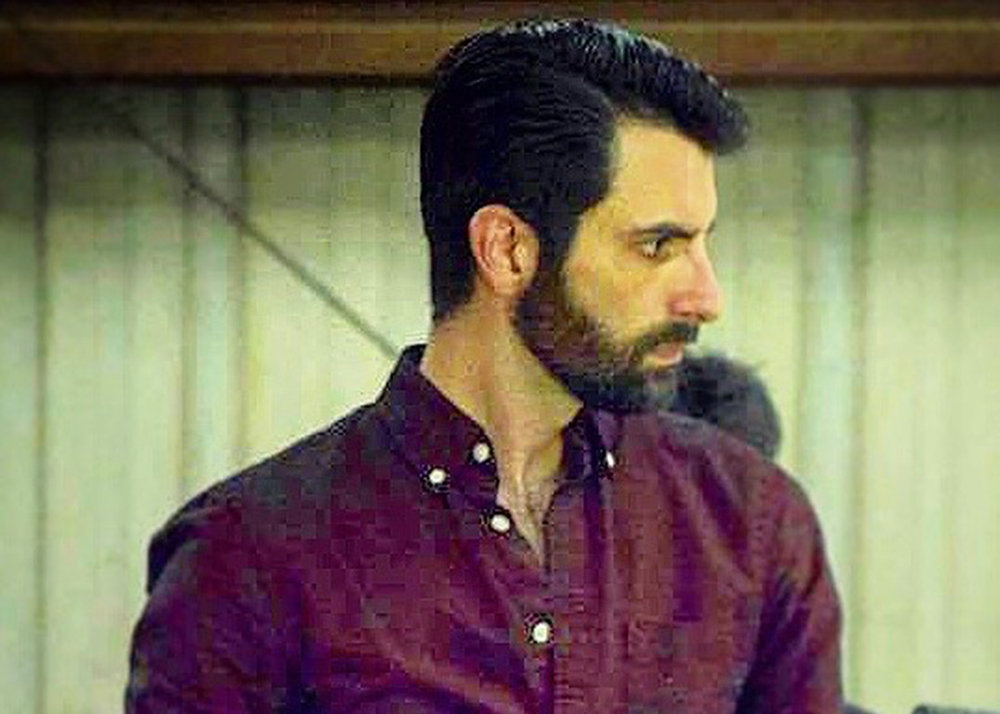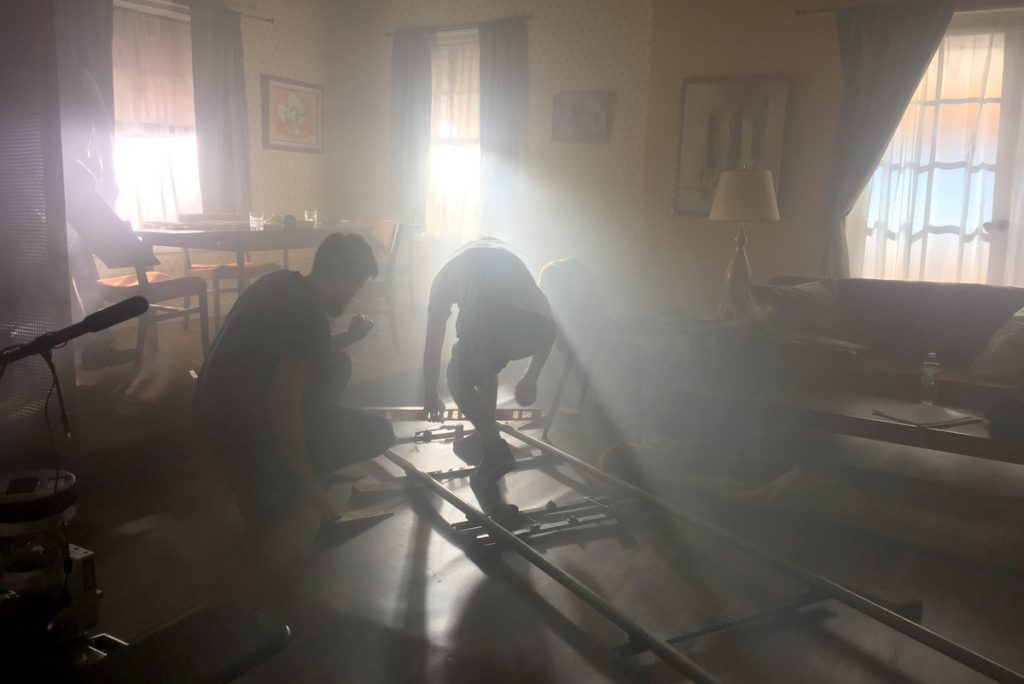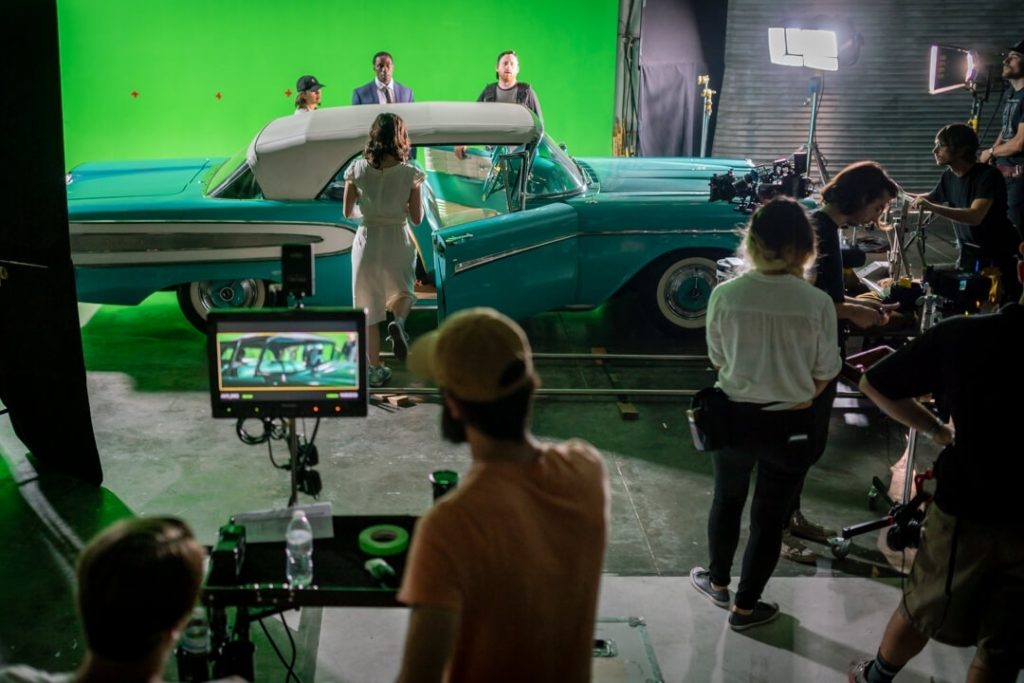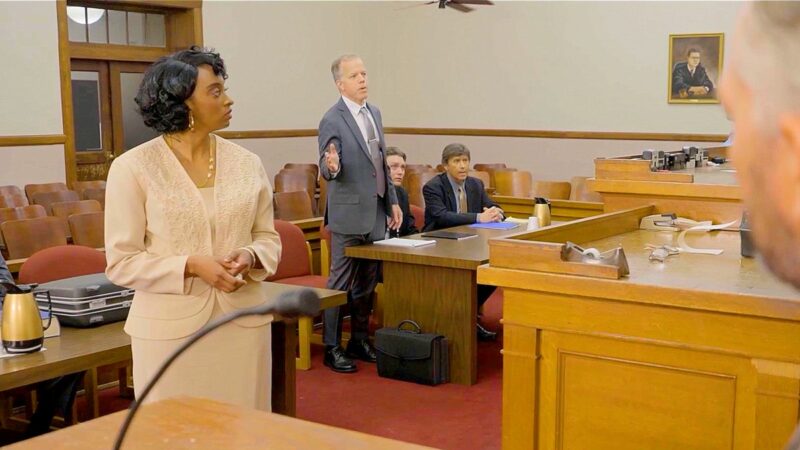
Jerome Stolly is a graduate of Academy of Art University were he studied cinematography. He works as a full time Director of Photography on films, commercials, and music videos, which led him to the role of a Director of Photography. Jerome created the visual for The Bumbry Encounter and he talks to us about his vision…
indieactivity : Introduce yourself, the story, the film by title, your crew?
Jerome Stolly : I’m Jerome Stolly and I was the Director of Photography on The Bumbry Encounter. This film had an amazing cast and crew that was led by Jay K. Raja (Writer and Director), Micah Embry Wilmott (Production Designer), Roth Rind (Producer and VFX) and myself.
indieactivity : How did you prepare for the production of the film?
Jerome Stolly : Jay first sent me the script in early 2016 and we immediately started a google drive folder where we started collecting images that inspired us. Over the next year we were looking at anything and everything from the early 1960s. Photos from old LIFE magazines, old cigarette ads, old car ads, old twilight zone episodes… anything that was from the time period was fair game. We also started compiling modern references. We wanted the movie to still feel like a modern movie despite being a period piece. If we saw a shot in a movie we liked or a certain frame or lighting we liked we’d add it to the google drive folder or text the each other and be like “you gotta see this”. Jay, Roth, and myself are also close friends so we’d go on weekend trips into the woods and hang out, drink beers and talk about the script and bounce ideas off each other. We didn’t talk about much else for the next year and a half until we finally went into production.
Related Story: Jay K. Raja’s ‘The Bumbry Encounter’ selected for Palm Springs ShortFest
indieactivity : How do you breakdown the script?
Jerome Stolly : When I breakdown a script I start at a basic narrative level. I’ll talk with the director (in this instance Jay) in more abstract terms and try to discuss their intentions in each scene. I ask questions like which character is dominant or “wins” this scene? What do we want the audience to be thinking about and feeling at this point in the script etc.? After I have those conversations I’ll either shot list directly with the director or we’ll each do our own and then meet and discuss. I always try and approach every shot with the director’s intentions in mind and motivate everything from a narrative or character perspective. Like we can do a push in here as this character has an epiphany or have this character step out of their key-light here when they decide to succumb to evil etc.
On Bumbry Encounter Jay never wanted the camera to move unless we had a good motivated reason so this helped us come up with creative framing and camera moves but also kept us from moving the camera just because it’s cool to move the camera. After we were done with the more esoteric ideas then I start having conversations with Roth about our technical needs and deciding which shots will be VFX, what will be practical, and what gear we will need to pull it off. Then I go through and mark the script line by line as what kind of shot it is and what gear we may need. Then that gets handed off to Roth and the Asst. Director and we schedule everything out.

indieactivity : You have a science behind what you do? Do elaborate on this technicality?
Jerome Stolly : I think a lot of cinematography is mathematical and scientific. I’ll need to know how many foot-candles I need in a scene in order to shoot at my preferred t-stop and inverse square law will help me decide where to put my lights and that is definitely part of the craft and a skill…But I think the art of it comes down to emotion. Something can be technically correct and still be wrong for the scene. For example you may need to underexpose a very dramatic scene or purposefully have something out of focus for a desired effect. Sometimes you have to trust your gut and trust the instincts of the people you’re working with and throw the science out the window.
indieactivity : How did you work with your crew on this project?
Jerome Stolly : I was lucky on this project and had the ability to work with my dream crew. Nearly all of the camera and electrical departments were staffed with good friends of mine from the Bay Area film community. I knew we had a really ambitious schedule and time was our most valuable resource so it was really important to me that I had a good report and short-hand with the crew. I’d ask my gaffer Craig Ryan to make a lighting adjustment and before I could even finish my sentence the adjustment would be made. Craig would just smile and say “I knew you were going to ask for that so I already had my guys on it”. I could communicate with just a nod or a look with most of my crew and most of the time they were so on top of things that I never even had to ask. I had worked with most of the crew before so I trusted them completely. I was always open to their suggestions and ideas. What is the point of hiring the best people if you aren’t going to listen to them?
indieactivity : During production, what scene (that made the cut) was the hardest to shoot?
Jerome Stolly : For budget reasons and logistical reasons we had to shoot the entire UFO encounter and car chase on green screen. I had never shot a big action set piece before and certainly never done one all on green screen. The first obstacle Jay and I had was to decide how dark we wanted to go with our night time look. Then we’d have to make sure that would work with what Roth was planning VFX wise and make sure that all the other elements would match to that in post-production.
We didn’t have a way of doing a live key to remove the green screen on set so we were looking at the actors in the car and trying to ignore the green screen and imagine the mountain road around them. Trying to decide if the moon light looked natural or if anything looked a little off when you’re surrounded by a green abyss is challenging to say the least. We were shooting on these older anamorphic lenses and they were a little too sol around the edges at a t-stop wider than a 4 so we had to sort of over light everything which also added to the challenge of it looking natural to our eye.
About half way through the first day of green screen work Roth was able to produce some dailies with a rough pre-viz environment replacing the green screen and we could all see that we were on the right track. We shot all the night exterior elements that would replace the green screen as miniatures so then we had to sort of have the same “how dark is too dark” discussion in post once we started layering everything together. Too bright and it looked too fake, too dark and you’d couldn’t see the actors. It was a delicate tight rope walk between myself, my colorist Dillon Mcevoy, and Roth with the vfx.

indieactivity : What works better in this latest production that mightn’t have worked so well in the last one you did?
Jerome Stolly : One of the coolest things we were able to do on this production was completely animate a rough pre-viz of the UFO chase. Using simple animations Roth and Jay were able to show me exactly what the shots for that sequence needed to be and how they were going to be edited together in the final film. It really sped up the shooting process because we were never shooting things that we didn’t need.
indieactivity : You lighted and shot the film, what measure of input did it take to don these hats?
Jerome Stolly : I had a lot of really long and in depth talks with Jay to understand where he was coming from aesthetically on this project. In order to achieve our goals I had to work with Micah (production designer) pretty closely and make sure she knew how big the set needed to be in certain places so the dolly and track could fit or where I needed windows so I could make sure I could motivate my lightning from the right side of the frame. I also had to work with Roth making sure we had all the right gear and crew and help production secure all those essentials, I had to coordinate with make up and wardrobe to make sure my lighting didn’t clash with anything they had planned. Every department would give and receive input in order to make sure the film really came together aesthe<cally once the camera was rolling.
indieactivity : Is there anything about cinematography in the independent filmmaking business you still struggle with?
Jerome Stolly : Surviving! Paying bills! Haha We all know indie filmmaking isn’t exactly a lucrative career choice. I think the business side of things is really challenging. Promoting yourself on social media without being annoying, meeting and greeting and networking at film festivals, book keeping…these are all things I don’t think I’m particularly good at.
indieactivity : Where do you think your strengths line as a cinematographer?
Jerome Stolly : First I want to say that I hope this doesn’t come across as me being full of myself or anything like that. There is a lot of ego in this industry and I don’t want any part of that. Cinematography is ultimately a collaborative effort and there is usually at least a dozen or so people working together behind every shot so I just want to shout out my crews because their strengths are my strengths when it come to the technical side of things. On the bigger more esoteric side of cinematography I think my strengths are communicating with the director and helping them translate their intentions into a cinematic language.
indieactivity : Let’s talk finance. Did you get involved with the finance of the film? How did you contribute?
Jerome Stolly : I wasn’t too involved with the finance side of things…I’m definitely not the guy you want as your accountant!
indieactivity : Tell us about your gear on this project?
Jerome Stolly : We shot on a Red Scarlet-W with Cineovision Anamorphic lenses for 90% of the film. Kowa Prominar, and Atlas Orion Anamorphic lenses were used on a few pick up shots.
indieactivity : How would you have shot this project if your budget was 3x the figure?
Jerome Stolly : Well my immediate answer is I would have doubled our shoo<ng schedule. Time is the most valuable resource on set and the one thing you can always use more of. I would have also loved to be able to do the UFO car chase on location. We were doing a lot of tests with lights on drones and doing that whole sequence practically but we just didn’t have enough resources to go in that direction. Also before we decided to shoot the film anamorphic Jay wanted to do something a bit more classical and shoot this in a 1.66:1 aspect ratio. I would have loved to have shot this in that format and on 35mm film.
indieactivity : How did you collaborate with the director on the project?
Jerome Stolly : On set I just let Jay focus on getting the performance he wants from his actors and he basically just lets me do my thing. By the <me we were on set we tried to have everything already figured out so we could just focus on telling the story and not worry about the technical logistics.
indieactivity : What do you hope audiences get from your work on this film?
Jerome Stolly : I hope they have a good time watching this and it makes them think. I really love genre film as social commentary. So if this can make people contemplate our current and past political situations and prejudices and also entertain them for 15 minutes then I’m happy.
indieactivity : What else have you got in the works?
Jerome Stolly : I have a few other short films that are currently released. “This is Fine” is a quirky end of the world drama/comedy that is finishing up its festival run. I actually wrote that one with Jay Raja and also shot it. Jay acts in it and it was directed by Roth Rind (producer of Bumbry Encounter). It was fun for me to try and write something as well as shooting it. “What’s to Come: Christmas Tradition” is a bleak sci-fi short that takes place on Christmas Eve that was released on DUST and Amazon Prime earlier this year (also directed by Roth Rind). I have my first feature film in post production. It is a murder/mystery called “Murder Bury Win” that revolves around a board game and board game fandom.
Tell us what you think of the interview with “Jerome Stolly” What do you think of it? What ideas did you get? Do you have any suggestions? Or did it help you? Lets have your comments below and/or on Facebook or Instagram! Or join me on Twitter @oladapobamidele
Follow Jerome Stolly on Social Media
Website
IMDb
Instagram
Vimeo
Richard Green Documentary, ‘I Know Catherine, The Log Lady’: Premiere in NYC, LA May 9th
Lynchian Doc I Know Catherine, The Log Lady Makes Hollywood Premiere 4/17, Rollout to Follow
In Camera by Naqqash Khlalid Launch on VOD April 29
Naqqash Khlalid’s Directs Nabhan Rizwan. In Camera stars an EE BAFTA Rising Star Award Nominee.
2025 Philip K. Dick Sci-Fi Film Festival Award Winners Announced
Vanessa Ly’s Memories of the Future Awarded Best PKD Feature
Dreaming of You by Jack McCafferty Debuts VOD & DVD for April Release
Freestyle Acquires “Dreaming of You” for April 15th Release
Hello Stranger by Paul Raschid set for London Games Festival & BIFFF
The film Is set for an April 10th Premiere at The Genesis Cinema in London (LGF) and BIFFF
Daydreamers Official Trailer by Timothy Linh Bui: Released by Dark Star Pictures
Daydreamers Vietnamese Vampire Thriller – May 2nd release









